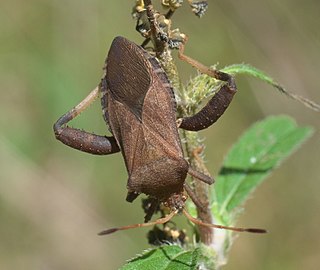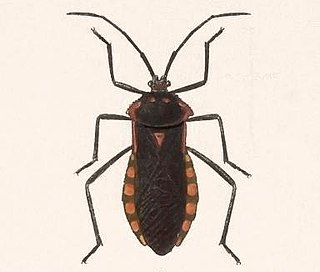
Coreidae is a large family of predominantly sap-suckling insects in the Hemipteran suborder Heteroptera. The name "Coreidae" derives from the genus Coreus, which derives from the Ancient Greek κόρις (kóris) meaning bedbug.

Alydidae, commonly known as broad-headed bugs, is a family of true bugs very similar to the closely related Coreidae. There are at least 60 genera and 300 species altogether. Distributed in the temperate and warmer regions of the Earth, most are tropical and subtropical animals; for example Europe has a mere 10 species, and only 2 of these occur outside the Mediterranean region.

Leptoglossus is a genus of true bugs in the leaf-footed bug family and the tribe Anisoscelini. Species are distributed throughout the Americas, with some records in eastern & southern Asia and Europe. Several species are economic pests of agricultural crops. Like members of some other genera in the family, these bugs have leaflike dilations of the hind tibia. Several species are of economic importance, and one species, L. chilensis, has been reported to bite humans.

Chondrocera laticornis is a species of leaf-footed bugs in the family Coreidae. They can be found along the east coast of South Florida. They are characterized by the flattened leaf like tibia of its legs, the dilated and segmented 2 and 3 antennal segments.

Acanthocephalini is a tribe of leaf-footed bugs in the family Coreidae. There are about 15 genera and at least 100 described species in Acanthocephalini.
Meropachyinae is a subfamily of leaf-footed bugs in the family Coreidae. There are at least 25 genera and 50 described species in Meropachyinae.

Pseudophloeinae is a subfamily of leaf-footed bugs in the family Coreidae. There are at least 20 genera and 100 described species in Pseudophloeinae.

Anisoscelis is a genus of leaf-footed bugs in the family Coreidae. There are about 11 described species in the genus Anisoscelis.

Mozena is a genus of leaf-footed bugs in the family Coreidae. There are more than 30 described species in Mozena.

Acanthocerini is a tribe of leaf-footed bugs in the family Coreidae. There are at least 20 genera and 50 described species in Acanthocerini.

Leptoglossus brevirostris is a species of leaf-footed bug in the family Coreidae. It is found in Central America and North America.

Spartocera is a genus of leaf-footed bugs in the family Coreidae. There are about 18 described species in Spartocera.

Narnia is a genus of leaf-footed bugs in the family Coreidae. There are about seven described species in Narnia.

Sephina is a genus of leaf-footed bugs in the family Coreidae. There are more than 20 described species in Sephina.

Anisoscelis alipes is a species of leaf-footed bug in the family Coreidae. It has been observed in Costa Rica, Colombia, Panama, Ecuador, Venezuela., and Mexico. It was first described by French entomologist Félix Édouard Guérin-Méneville in 1833. Anisoscelis flavolineatus, previously considered a distinct species, is currently considered a synonym of A. Alipes.
Anisoscelis caeruleipennis is a species of leaf-footed bug in the family Coreidae. It was first described by French entomologist Félix Édouard Guérin-Méneville in 1838. Its status as a member of genus Anisoscelis was disputed in 2014.

Anisoscelis discolor is a species of leaf-footed bug in the family Coreidae endemic to Ecuador. It was first described by Swedish entomologist Carl Stål in 1854. Stål originally described the species as coming from "Taiti" (sic). However, Brailovsky (2016) notes that the Anisoscelis genus has an exclusive Neotropical distribution and the original data must have been the result of a mistaken label.

Anisoscelis scutellaris is a species of leaf-footed bug in the family Coreidae endemic to Colombia. It was first described by Swedish entomologist Carl Stål in 1870.

Anisoscelis luridus is a species of leaf-footed bug in the family Coreidae. It was first described by Harry Brailovsky in 2016 and it has been recorded in Texas, Mexico, Central and South America.

Anisoscelis marginellus is a species of leaf-footed bug in the family Coreidae. It was first described by William Dallas in 1852 and it has been recorded in Brazil and Argentina. It was previously considered a subspecies of A. foliaceus





















